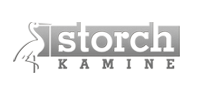Advice and tips
The main questions and answers about stoves and heating.
- WHAT DO I NEED TO KNOW BEFORE BUYING A FIREPLACE STOVE OR FIREPLACE INSERT?
- WHAT TYPES OF ENCLOSURES ARE AVAILABLE FOR FIREPLACE INSERTS?
- USE AND OPERATION OF FIREPLACE STOVES AND INSERTS
- CHIMNEY TIPS
- CLEANING AND MAINTENANCE TIPS
- WHERE CAN I BUY SPARE PARTS FOR STORCH FIREPLACE STOVES AND INSERTS?
- WHO CAN I CONTACT IN CASE OF A WARRANTY CLAIM OR FOR SERVICE SUPPORT?
The correct function of fireplace stoves or inserts requires a suitable chimney (minimum diameter, draft, seal, etc.). You should therefore consult a professional, for instance a chimney sweep, before installing/fitting a fireplace stove or insert. You will find the required values for the chimney on the technical sheet for the specific product.
If the chimney draft is insufficient, your fireplace stove or insert cannot work properly. The chimney draft works based on the difference in temperature inside the chimney and outside, which is usually lower.
- there is large difference between the temperature inside the chimney and outside.
- the chimney has the right structural height.
- the temperature difference is low and the outside temperature is high.
- it does not have the right structural height, or is situated in the shadow of its own roof or the roof of another building.
- “false” air enters the chimney due to its poor (critical) condition
This is directly related to sufficient chimney draft, temperature differences inside the chimney and outside, the quality of burned wood (the moisture content of wood should not exceed 20%).
The draft may decrease during warm weather or there may be cracks in the chimney, the chimney is not properly insulated or its structural height is too low. We recommend inviting a professional - a chimney sweep - to inspect the chimney, measure the chimney draft and propose the optimum solution.
The minimum effective height of the chimney for flue gas exhaust from a fireplace stove is 5 meters (measured from the clamping ring to the chimney outlet). However, we still recommend discussing the chimney height, dimensions and construction with a professional - chimney sweep - as your local conditions could mean that even 5 meters is not enough.
The structural design of the chimney, the size of its vents and effective height will correspond to the nominal output of the installed fireplace stove or insert. Steel or ceramic materials are the most frequently used. Please consult your questions and requirements with an expert or your chimney sweep.
You need to have a chimney sweep check the chimney at least once per year.
Flues are checked by a chimney sweep or inspecting technician. When checking, it is imperative to allow the appropriate expert to access all parts of the flue, i.e. from the appliance to the outlet of the given chimney, and also the roof of the building and chimney doors (in order to allow the problem-free removal of soot).












